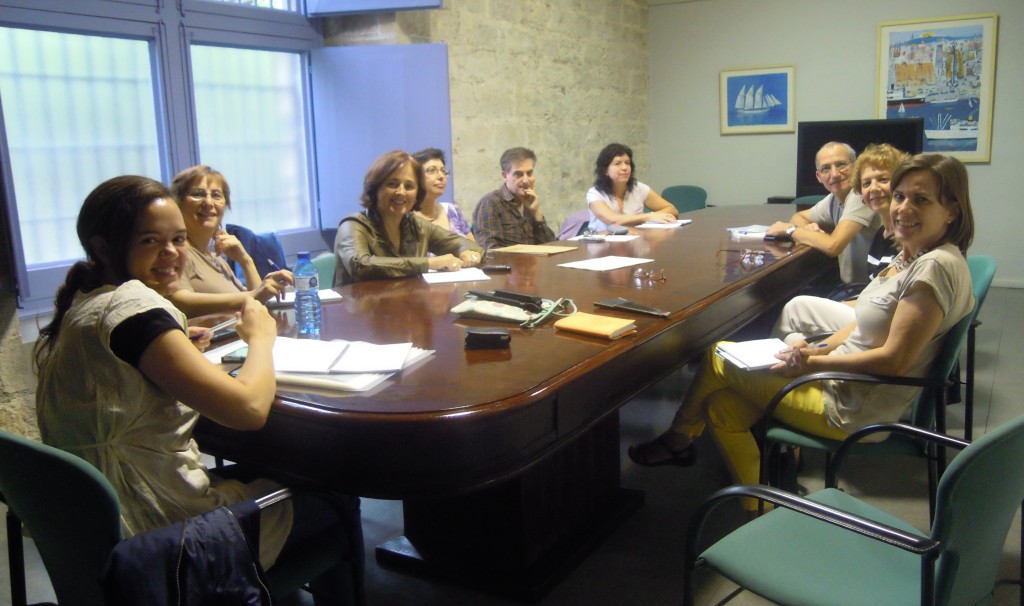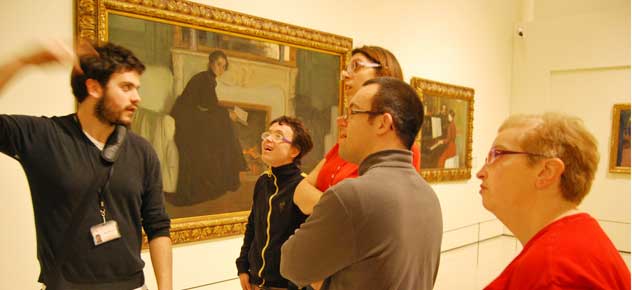Teresa González
Accessibility in museums is a long journey and a milestone which we are still a long way from achieving. Since 1999, the year in which the Education Department of the Museu Nacional d’Art de Catalunya started its programme Museum space in common –which carries out specific projects for groups suffering from mental disorders and functional diversity, many years have passed. Throughout these years the museums of our country have become aware of the fundamental role they play to ensure the full right of the people to access culture.
But this museums’ mission is still fulfilled in an unequal way. We often find that due to the sensitivity of some people, the institutions have covered these spaces with specific programmes or with services aimed at specific target groups. Only a few facilities that have been recently reformed or have been newly created (Museu Blau) have developed an accessibility plan that ensures, to a certain extent, universal accessibility.
It was based on this awareness and the need to exchange experiences that the working group, Museums and accessibility, was born and constituted in May 2013. The sessions are habitually held in the Maritime Museum of Barcelona (In Spanish).
The group is designed as a meeting of museum professionals, similar to the Anglo-Saxon communities of practice, with the aim of sharing knowledge, resources, and often, doubts which arise about topics related to accessibility. Among the goals, are:
- to go in depth and develop policies of accessibility
- to get to know other projects and activities carried out by other institutions
- to provide mutual support and to learn from each other
It is precisely for this reason that for us the importance of the group lies in its structure, and as we have said above, has a similarity to the so-called communities of practice, which can be organised in various ways, but with all of them combining three fundamental elements:
- the domain, an area of work that defines the identity of the group
- the community of the members who make up the working group and who agree the topics of interest, the aims and the way of working
- the practice, because the members are active professionals who share resources and knowledge and apply these to their own work
We believe that it is worth highlighting the fact that the group was created by the will of the members, based on an agreement between professionals, and not by a decision of the institutions. This has allowed us to act in a horizontal way, without department or organic borders.
Technicians from the following centres form part of this group:
- Museu Marítim de Barcelona
- Centre de Cultura Contemporània de Barcelona (CCCB)
- Museu Nacional d’Art de Catalunya
- Museu del Disseny de Barcelona
- Fundació Miró
- Fundació Tàpies
- Museu Picasso de Barcelona
- Museus de Sant Cugat
- Museu de Sant Boi
- Museus de Sitges
- Oficina de Patrimoni de la Diputació de Barcelona
- Agència Catalana de Patrimoni Cultural
Throughout this time, the Community of Practice of Museums and accessibility has carried out a wide range of interactions and diverse activities, among which it is worth highlighting:
- exchange of information about experiences, projects and activities related to topics of accessibility. Whenever they could, the group has presented some experience in conferences which deal with accessibility
- organisation of technical visits to the facilities to get to know specific projects first-hand: the project LAC Art Community Laboratory (in Spanish) and the programme Hermes (in Spanish) in the Museum of Sant Boi; the temporary exhibition Design for life, in the Museu del Disseny de Barcelona; the accessibility plan of the Museu Blau; the project Fem un museu (Let’s make the museum – in Spanish) of the Museums of Sant Cugat, among others
- proposal of coordination of the programming of activities, such as the platform Apropacultura (get close to culture)
- support in carrying out projects and activities
- search for solutions to problems that emerge from our professional practice
- search for external advice and assessment who provide us with the necessary knowledge in specific topics: Yolanda Anguita, from the Municipal Institute for the Disabled of Barcelona, and Josep M. Llop, currently adviser from the Diputació de Barcelona (Barcelona Provincial Council) in themes related to visual accessibility, to give a couple of examples. The presentation was held, given by Mikel Asensio and Joan Santacana, from the research project Cultural Inclusion in Heritage, carried out by the University of Barcelona and the Autonomous University of Madrid
- development of collaborative learning and collected from the contents of the meetings in the minutes of the meetings
- generation of common projects, such as the blog Museums and Accessibility (in Spanish).
What do we hope to get out of our community of practice?
Forming part of this group helps to foster personal and professional development in questions of accessibility. This reverts back in an improvement of our daily tasks and in the awareness-building of the institutions we represent with the medium-term goals of achieving the highly sought-after universal accessibility to culture of everyone, irrespective of their skills, background, socio-economic level, or ideology.
Related links
Accessibility in Museums and Libraries, IMLS (Institute of Museums and Library Services)
Accessibility Program, Smithsonian
Access programs at the Met
Disability and Access, Victoria and Albert Museum
The Ultimate Guide to wheelchair accessible Barcelona, Spain
Departament d’Accessibilitat i Inclusió











